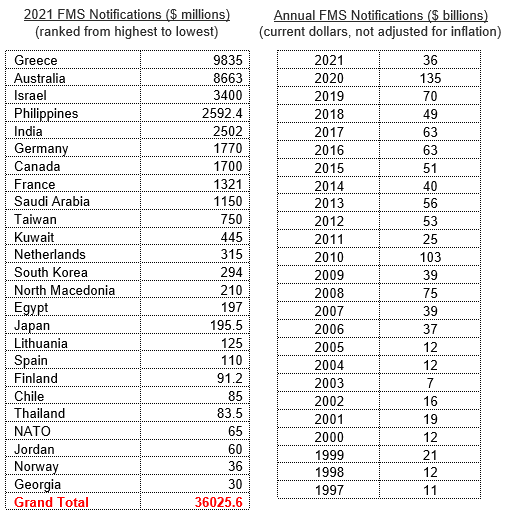| This is the fourth blog post in a series looking at an array of issues in 2023 related to weapons use, the arms trade and security assistance, often offering recommendations. |
On the other hand, the war contributed to the significant expansion of the South Korean defense industry. Its new arms export sales more than doubled in 2022 (about $17 billion compared to $7.5 billion in 2021) mostly due to a huge deal with Poland ($12 billion). This also diversified destinations of South Korea’s weapons to a major European NATO member. The number of NATO countries that import South Korea’s weapons may increase in the near future. For example, Norway and Estonia have expressed interest in buying weapons from South Korea since the outbreak of Russo-Ukrainian War. What does this mean to South Korean defense industry and its role in the global arms market this year and into the near future?
South Korea’s defense industry
The development of South Korean defense sector is largely attributed to the political tension with North Korea. Because both Koreas are technically still at war, the South Korean government has consistently and thoroughly invested in its defense industry since the 1970s. The government’s strong push to try to produce its own defense weapons has led the country’s defense industry to become not only a producer, but also an exporter of howitzers, battle tanks, warships, and other weapons. In addition, South Korean weapons are compatible with Western NATO weapons, particularly US ones. This is largely due to the country’s close relationship with the US as both countries regularly conduct joint military exercises and engage in an active R&D. This benefits the recipients of South Korean weapons. For example, the arms deal between Poland and South Korea last year gives Poland a chance to replace their old Soviet-era arms into more advanced technology that is compatible with US and other NATO members’ weapons.
In addition, South Korean defense companies can produce and export the weapons in a timely manner with relatively cheap prices and generous technology transfers. These are also crucial factors that have made the South Korean weapons competitive in the global arms market, which has been enhanced with the Russo-Ukraine War as major producers focus on providing weapons to the conflict. For example, even though Poland originally was interested in importing German howitzers, the German government kept postponing exporting them largely due to prioritizing exporting to Ukraine. In addition, South Korean defense industry is more open to transfer technologies, overseas production, and R&D. These factors made South Korean weapons great alternatives for countries that want to replenish their military capabilities with reasonable conditions. After seeing the recent deal with Poland, it is probable that other countries are also interested in importing arms from South Korea. Last year, countries such as Romania expressed their interests to purchase weapons from South Korea, as did Norway and Estonia, as mentioned earlier.
Can South Korea replace Russia in the global arms market?
For now, it seems unlikely. While aircraft comprise almost half of Russian arms exports between 2016 and 2020, there are only a few light combat aircrafts that South Korea has successfully exported. In addition, as many South Korean weapons still include components that are produced by foreign manufacturers, exporting the weapons require additional permission from those countries. For example, in 2020 South Korean K9 Thunder howitzers that use German diesel engines were prevented from being exported by a German defense export ban. Considering that the majority of foreign manufacturers that either coproduce or provide components of South Korean weapons are from Western countries, exporting South Korean arms to former clients of Russian arms exports (such as China, or Iran) is likely to be very difficult.
There are, however, signs that South Korea is becoming more favored in the global arms market by some Russian arms importers. For example, after having bought howitzers from South Korea in 2021, Egypt has expressed its interest to buy South Korean aircraft as well. Egypt was the fourth largest arms importer of Russian weapons between 2016-2020. Also, Vietnam, another major importer of Russian arms for decades, recently bought arms from South Korea.
Conclusion
Some experts may suggest that last year’s increase in South Korean defense industry’s exports could be just a short-term change due to the demand caused by the Russo-Ukrainian War. In addition, South Korean defense industry still has major limitations of being dependent on foreign manufacturers for some internal components of their weapons. However, the growth of the country’s defense industry did not just happen in a day. Instead, the country’s arms industry has made progresses to become more competitive in the global arms market. If recently exported arms are deployed and judged reasonably well-performing this year, the country’s arms industry will become more competitive and credible. If that is the case, South Korean defense industry may export more weapons now and in years to come.
Hoshik Nam is a PhD candidate in Political Science at the University of Iowa and a member of the Forum’s Emerging Expert program.
Inclusion on the Forum on the Arms Trade expert list and the publication of these posts does not indicate agreement with or endorsement of the opinions of others. The opinions expressed are the views of each post's author(s).










 RSS Feed
RSS Feed